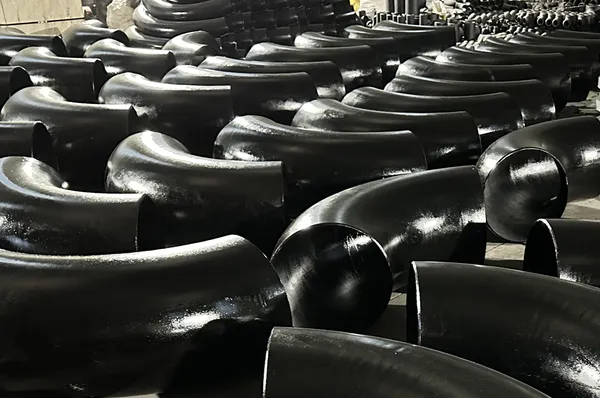In various pipeline systems, elbows are important pipe fittings that change the direction of fluids. Their service life is directly related to the safety and economy of pipeline operation. So, how long is the service life of elbows? This article will analyze the service life of elbows and their influencing factors from multiple dimensions such as materials, environment, and working conditions.
General elbow service life
Generally speaking, its service life may range from 5 years to decades, or even longer. The following is a detailed analysis of the service life of pipe elbows and their influencing factors:
General situation: The service life of common pipe elbows such as tap water pipe elbows is usually 5 to 10 years. However, this time is not absolute, because the actual service life will be affected by the combined effect of many factors.
Special situation: Under certain conditions, such as the use of high-quality materials (such as stainless steel) or specially designed elbows (such as wear-resistant ceramic lined composite steel pipes), its service life may reach decades or even longer.
Comparison table of service life of different elbows
Generally, standard carbon steel or galvanized elbows used in basic conditions have a service life of 5 to 10 years. However, elbows made from stainless steel, alloy steel, or composite materials can last 15 to 50 years, and in ideal conditions, over 50 years. Below is a reference table for different materials:
|
Material Type
|
Service Life
|
Typical Application Scenarios
|
|
Carbon Steel Elbow
|
5–10 years
|
Tap water, general industrial fluids
|
|
Galvanized Elbow
|
8–15 years
|
Low-corrosive water systems
|
|
Stainless Steel Elbow (304)
|
15–30 years
|
Building water supply, food industry
|
|
Stainless Steel Elbow (316)
|
30–50 years
|
Seawater, chemical, pharmaceutical
|
|
Ceramic Lined Elbow
|
20–50 years
|
Slurry, coal powder transportation
|
|
Special Alloy Elbow
|
40–60 years
|
Highly corrosive or high-temp use
|
Reasons affecting the life of pipe elbows
In actual applications, the service life of elbows is affected by the following key factors:
1.Material quality
The performance of the material used for the elbow directly determines its corrosion resistance, pressure resistance, and wear resistance. For example, carbon steel elbows perform well in ordinary industrial transportation, while stainless steel or alloy steel elbows are suitable for high corrosion and high temperature environments. The better the material, the longer the service life.
2.Working environment
The environment in which the pipeline system is located has a significant impact on the life of the elbow. If the medium is highly corrosive (such as acid, alkali, salt solution), or the ambient temperature and humidity are high, the corrosion and aging of the elbow will be aggravated, shortening its service life.
3.Medium characteristics
The temperature, pressure, flow rate and whether the fluid contains solid particles will affect the wear and fatigue of the elbow. For example, when conveying slurry containing sand particles, ordinary steel elbows may wear quickly, while ceramic lined elbows can significantly extend their life.
4.Manufacturing process
The manufacturing accuracy and process quality of the elbow are crucial to its structural strength and sealing performance. Excellent welding technology, precise bending angles and smooth inner walls can reduce stress concentration and fluid erosion, and improve durability.
5.Installation and maintenance
Reasonable installation and regular maintenance can effectively prevent leakage or damage to the pipeline system caused by stress concentration, vibration or improper connection. Timely replacement of aging parts and removal of deposits can also help extend the service life of the elbow.
6.Design selection
The type and structure of the elbow (such as long radius elbow, short radius elbow, tee elbow, etc.) should be scientifically selected according to the use conditions. Improper design may lead to problems such as excessive local flow velocity or stress concentration, thus reducing the service life.

How long is the service life of stainless steel pipe elbows?
The service life of
stainless steel pipe elbows is usually long under normal working conditions, generally reaching 15 to 50 years, and even more than 50 years under certain ideal conditions. Corrosion test data show that the service life of stainless steel elbows can reach 100 years, and stainless steel elbows require almost no maintenance. Therefore, it has a good cost performance, low operating cost of life, and significant economic benefits. Compared with the multiple seam "cross-cut" type, the weld is not so important, there is no corrosion of the front weld, and the subsequent flushing, the corrosion situation is better.
How to Extend the Service Life of an Elbow
To maximize the lifespan of elbow fittings, consider the following strategies:
Choose the right material: Select stainless steel, alloy steel, or composite materials based on the fluid and environmental conditions.
Optimize elbow design: Choose long-radius or short-radius elbows appropriately to avoid erosion due to high fluid velocity.
Ensure manufacturing quality: Use products from reputable manufacturers with certified welding and heat treatment processes.
Install with care: Prevent torsion, misalignment, and concentrated stress.
Schedule regular maintenance: Especially in corrosive or high-pressure environments, inspect wall thickness and check for corrosion regularly.
In summary, although there is a certain reference range for the service life of elbows, the actual situation needs to be comprehensively evaluated in combination with the above factors. In order to ensure the long-term safe operation of the pipeline system, it is crucial to select high-quality elbows and combine them with scientific management and maintenance strategies.






 English
English Español
Español بالعربية
بالعربية











 Phone :
Phone :  Whatsapp :
Whatsapp :  Email :
Email : 


